Christo's Corridor Store Front: Social Isolation and the Wildly Ordinary
Title: Christo’s Corridor Store Front: Social Isolation and the Wildly Ordinary
Authors: Beth George with Emerald Wise
Keywords: Christo, Drawing, Imaginative Attention, Corridor Store Front, Isolation
1 ABSTRACT
This essay was written during a COVID-19 lockdown period. It was prompted while contemplating an image of Christo’s Corridor Store Front project, which spurred a rumination on architectural drawings as portraiture, on the reciprocity between the drawer and viewer of an image, and on the capacity for a drawing’s construction to invite an active exchange. These concepts are discussed alongside an observation regarding beauty and pleasure in the midst of social isolation and confinement—the contraction of spatial experience—that has taken place during the global pandemic. In this historical moment, a profusion of impromptu artworks has emerged across social media channels. This essay suggests that everyday happenings occurring in people’s homes have found an attuned audience who have engaged with their environments with aesthetic perception and captured incidental and temporal compositions around them. The mundane has, in this way, been collectively transposed into the phenomenal. Finally, the essay asks whether architectural drawings can deliberately preserve space for their completion in the mind of a viewer, and proposes that familiarity could be understood as an invitation into imaginative attention.
2 ESSAY
PREAMBLE
This essay discusses an image that I willfully knew nothing about (not even its title) at the time of its writing. I am aware that I may have misinterpreted the drawing, bent it to my
own thinking, but as this essay is about the reception of work—its reading as opposed to its writing—this naivety was intentional and hopefully forgivable.1 The resonance that
this deep drawing, or thin model, has held for me since I saw it has become synonymous with this rare and specific moment in time: of confinement, and observation, within one’s
home. The post-amble was written after seeking information about the nature of the drawing and Christo’s intentions behind it. The centre must then be seen as just an amble
—as some thoughts taken for a walk: an activity that has become a quintessential part of life in 2020 for many
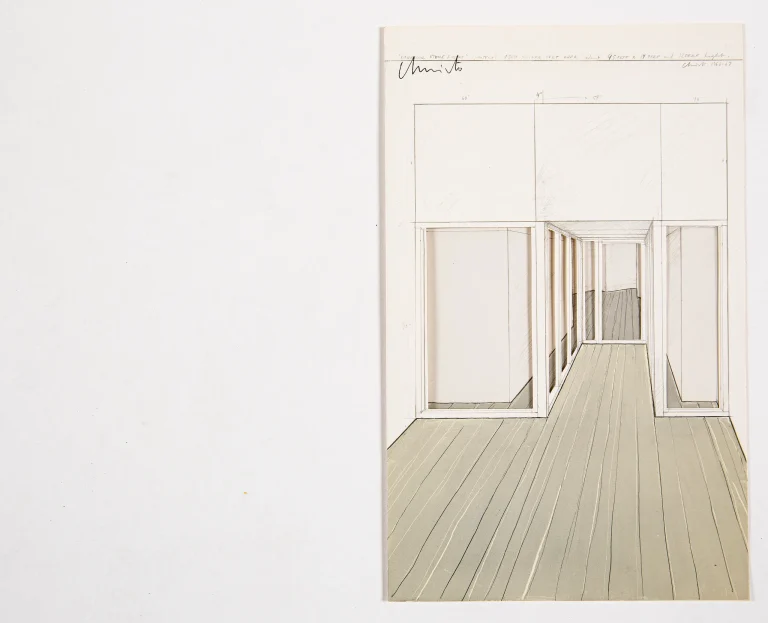
Christo (1935–2020), drawing for Corridor Store Front (project), 1966–67. Folded collage drawing, 275 x 170mm (folded), 275 x 342 mm (unfolded). Image courtesy of Drawing Matter Collections. (c) The Estate of the Architect.
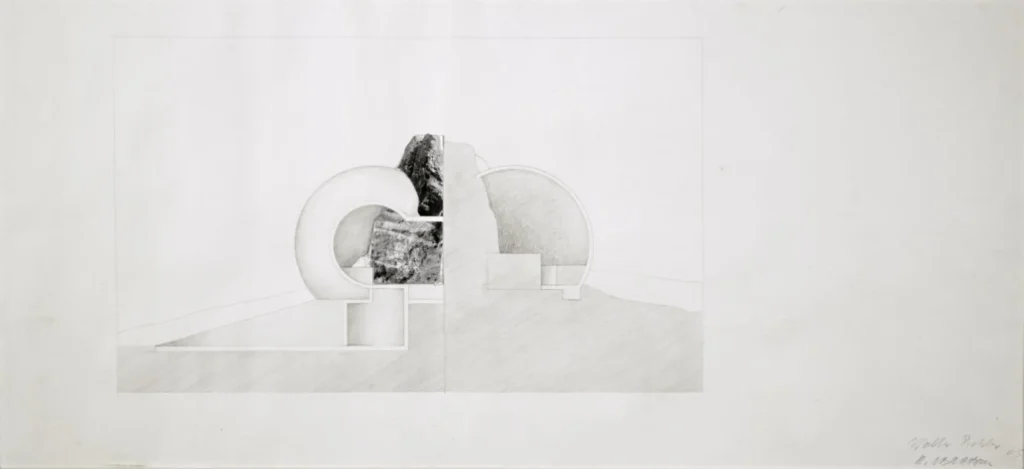
Walter Pichler and Raimund Abraham, House, Oggau, Burgenland, Austria, 1963. Image courtesy of SFMOMA.
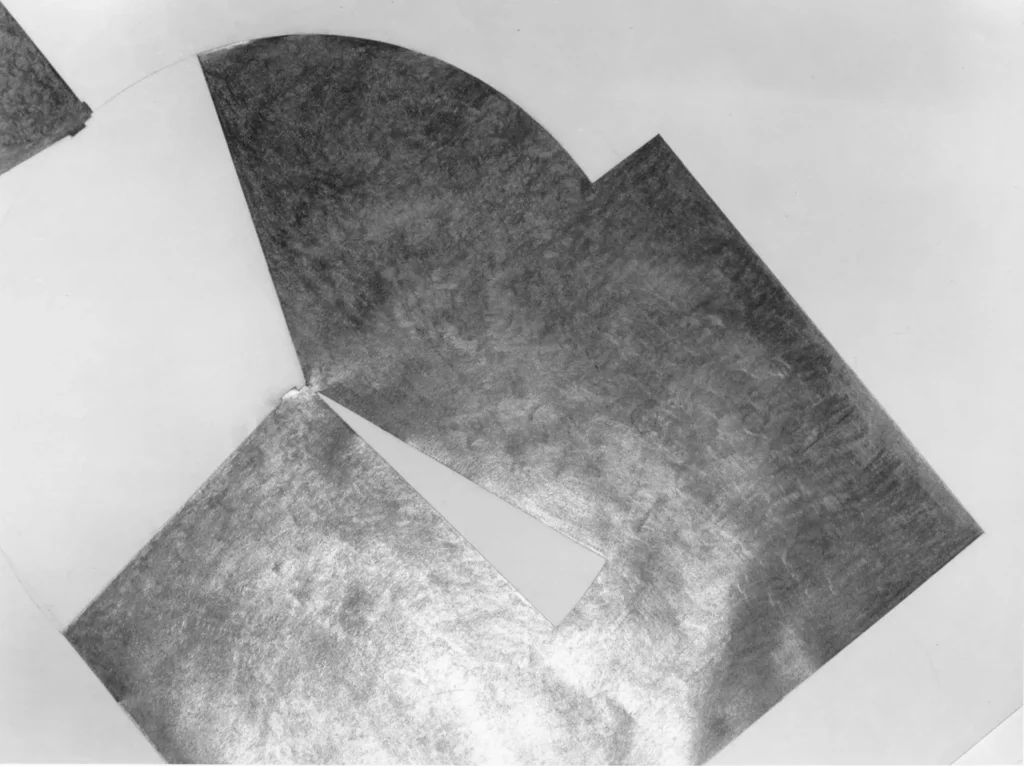
Elizabeth B. Hatz Permanent Door Swing, 2002-2004. Photo: Gunnar Smoliansky. Image courtesy of Elizabeth Hatz
Where these drawings are transporting in part because they are elusive, the Corridor is utterly plain. Yet, I cannot think of it simply as a picture of a room: it is a portrait of a room.
What is the difference between a picture and a portrait? It might be described as essence: that a portrait captures something that is not just representational—a likeness that is more about a feeling than an accurate resemblance. When a portrait of a person is compelling, it is because something more-than-visual is caught, something of the subject’s personality or character, a fleeting or interior thing. 3
When John Berger described Van Gogh’s canvases, he said that the “stuff of the painted image,” a chair, for example, is “analogous to the activity of the existence of what he is painting. His paintings imitate the active existence—the labour of being—of what they depict. 4 This is not just a matter of translation but of reconstitution: it is described by Berger as a highly physical reconstruction, in which tectonic parts are assembled in the work— “as though he too were fitting them together, joining them, and as if this being joined constituted their reality”. 5 In this way, their physicality embedded in the painting, these parts continue to work.
Perhaps there is another kind of continued exertion here, which might be thought of as material embodiment—the amassed energy layered into the painting itself. It might be said that the stroke of a brush, or the love given to a detail, continue to actively exist in the work in the same way as the object continues to perform for Berger. There is the labour of the subject—its ongoing tectonic fitting, its resistance of gravity, its substance that casts shadows—but there is also the labour of the act of making the painting. The embedding of media and effort and mood are present, persistent accretions, held and embodied in the work but spiralling out from it in time, in both directions.
But the durational dimension in Christo’s Corridor is not only about the artist’s making of the work—it is the fact that it insists on revealing the extraordinary in the ordinary. Christo died in May, 2020. His life and work were commemorated by the Drawing Matter organisation, who, on hearing of his death, posted an image of his Corridor Store Front social media. In this way, the image became symbolic of a moment in time: not of the moment when it first emerged, but rather, the moment of the artist’s passing. The image
—of a quiet and shrouded room—became accidentally, but deeply, symbolic of experiencing lockdown and social isolation. 6 One peculiar effect of this unique period, wherein the Coronavirus pandemic has restricted human activity and confined many of us to our homes for varied lengths of time, has been the propensity for people to capture phenomena playing out in visual spectacles on their walls, across ceilings and rumpled bed linen. Living in lockdown has forced people to be exposed to artworks being made and re-made around them by simply contemplating the banality of their everyday environment. Some of these spectacles have been discovered in bored or abstract thought, and others far more deliberately noticed, but our lockdown period has seemed to generate a profusion of photographs capturing magical compositions made by the interactions between dwellings and weather.
Isolation in Australia began in late autumn. From inside our homes, many began to document fragments of our days through images that reflect a renewed sense of attention: low-angled light moving through textured glass, through blinds, past mullions and houseplants, to land shadows on gritty walls. Visual media channels are replete with such household marvels—it seems the phenomenon of the ordinary, the secrets of the dwelling—that usually play out while its occupants are elsewhere, have now found an attuned audience. How glorious it would be to imagine a pleasurable side to the global pandemic: a universal outbreak of imaginative attention…
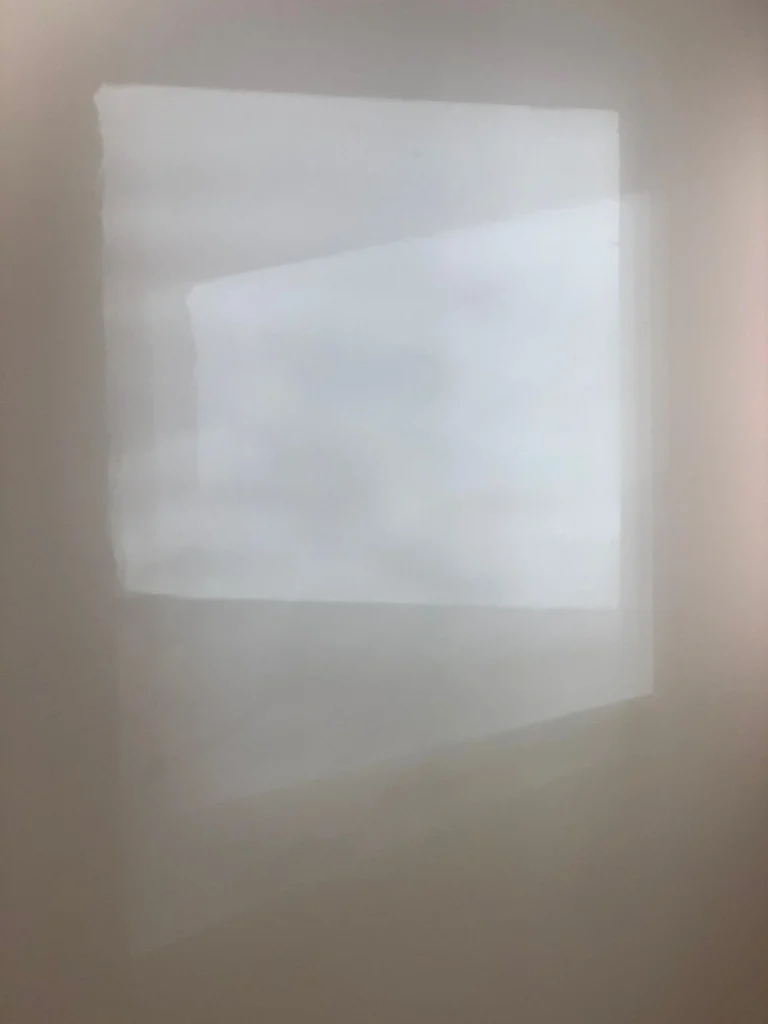
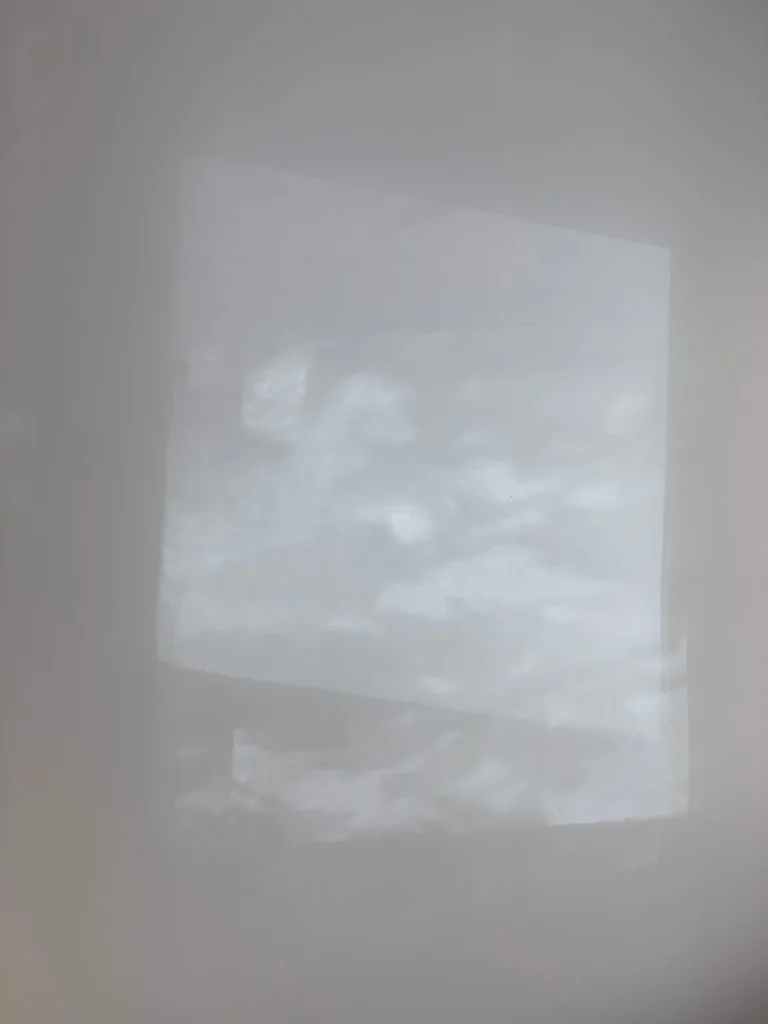

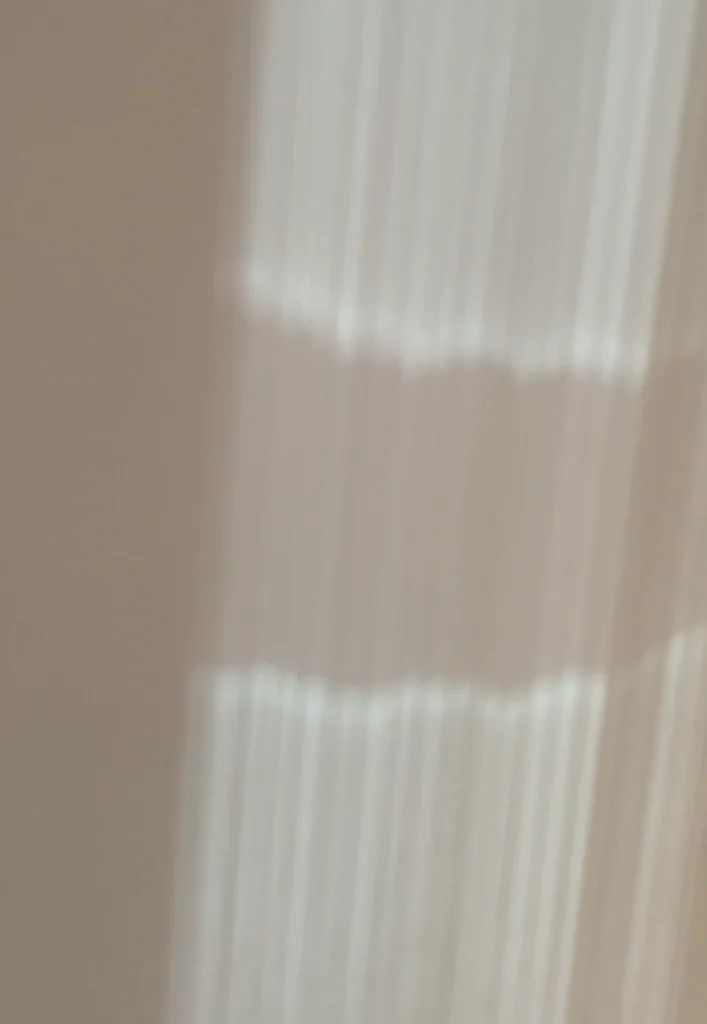
Light drawings, author’s ceilings, July/August 2020
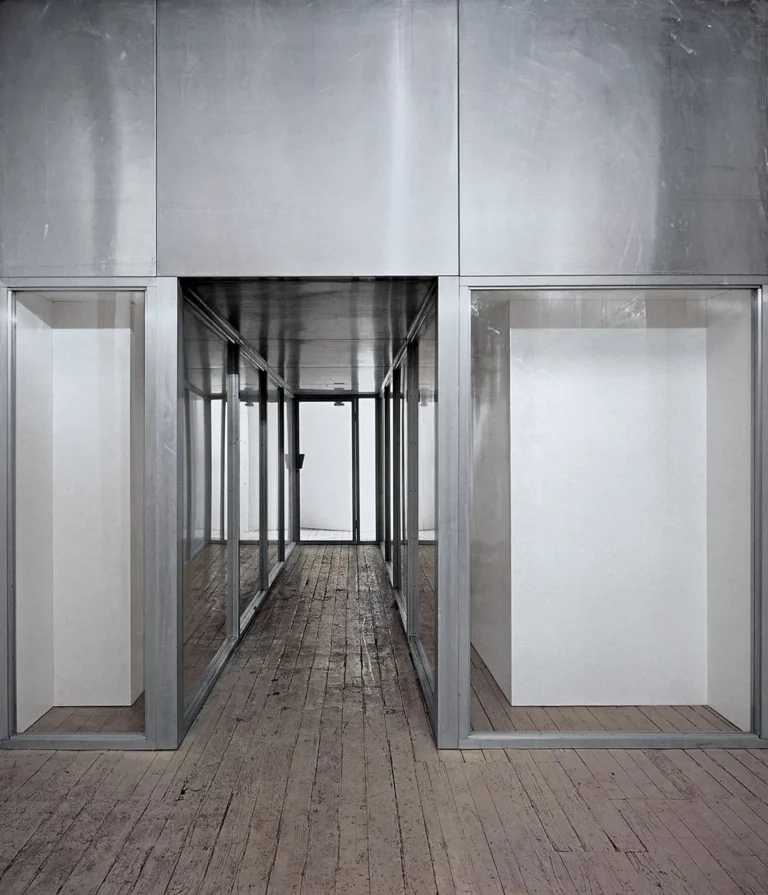
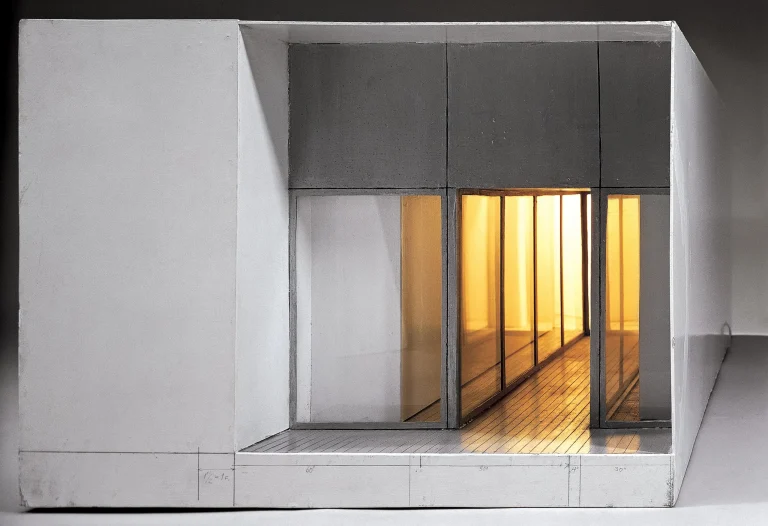
Christo, Corridor Store Front (Project), installation photograph and scale model 1966-1967. Photograph: Wolfgang Volz. Copyright 1967 Estate of Christo V
Javacheff.
3 ACKNOWLEDGEMENT
Conversations around architectural drawings as portraiture, the cultivation of aesthetic attention and the manner in which we might be brought into the space of the artwork were with Emerald Wise—our dialogues about architecture and drawings are constant— held while sitting, walking, driving. I have written the words, but, I am indebted to her for these concepts.
4 REFERENCES
Barthes, Roland. 2000. Camera Lucida. London, England: Vintage.
Berger, John. 2005. And our faces, my heart, brief as photos. London, England: Bloomsbury.
Evans, Robin. 1986. “Translations from Drawing to Building.” AA Files, no. 12 (Summer), 11.
Fenner, David E. 2004. “In Celebration of Imperfection.” The Journal of Aesthetic Education 38, no. 2 (Summer): 67.
Halbwachs, Maurice. 1992. On Collective Memory. Chicago, USA: University of Chicago Press.
Hatz, Elizabeth. n.d. “Permanence: Drawing as Adjuration.” Drawing Matter Archive.
Jones, Amelia. 2012. “Foreword: Kinaesthetic Empathy in Philosophical and Art history: Thoughts on How and What Art Means” in Kinaesthetic Empathy in Creative and Cultural Practices. Bristol, England: Intellect.
Lefebvre, Henry. 1974. The Production of Space. Malden, MA: Blackwell.
Lyndon, Donlyn, and Chales W. Moore. 1994. Chambers for a Memory Palace. Cambridge, MA: MIT Press.
Merleau-Ponty, Maurice. 2012. Phenomenology of Perception. Oxon, London: Routledge.
Ricoeur, Paul. 2004. Memory, History, Forgetting. Chicago, USA: The University of Chicago Press.
Scruton, Roger. 1974. Art and Imagination: A Study in the Philosophy of Mind. London, England: Methuen & Co.
“Show Cases, Show Windows, and Store Fronts.” n.d. Christo and Jeanne-Claude. https:// christojeanneclaude.net/projects/show-cases-show-windows-and-store-fronts
Strawson, P.F. 1970. “Imagination and Perception” in Lawrence Foster and J.W. Swanson Experience and Theory. Amherst, MA: University of Massachusetts Press.
5 AUTHOR BIOGRAPHY
Dr Beth George is an educator and practitioner in architecture, with a research focus on urbanism, design and drawing. She has a PhD from RMIT in urban curation, which looks to cartography as a mechanism for reading cities in order to generate distinctive and placeful architectural propositions.
Beth researches and publishes through book chapters, journal articles and papers, competitions, exhibitions and curation. Beth is a registered architect. She has received awards for both her teaching and architecture practice. Beth has been at the University of Newcastle since 2019 and has taught at the University of Western Australia and Curtin University over the prior 15 years.
CITATION
1
“Imagination is simply one way of thinking of, and attending to, a present
object… the object serves as a focal point on which many different thoughts
and feelings are brought to bear.” Roger Scruton, Art and Imagination: A Study
in the Philosophy of Mind (London: Methuen & Co, 1974), 155. While understanding an author’s intentions can be illuminating, to read an image without knowing its context might be to engage with it genuinely through imaginative perception.
2
See Elizabeth Hatz, “Permanence: Drawing as Adjuration,” Drawing Matter Archive
3
This is elucidated by Roland Barthes’ concept of air, where the image of a
subject coincides with “a sudden awakening, outside of ‘likeness,’ a satori in
which words fail, the rare, perhaps unique evidence of the ‘So, yes, so much
and no more.’” See Roland Barthes, Camera Lucida (London: Vintage, 2000), 109.
4
John Berger, And our faces, my heart, brief as photos (London: Bloomsbury, 2005), 74
5
Berger, And our faces, 74
6
It may be worth noting the bareness of Christo’s depicted room: I first (mis)read its foreground space as an empty interior. The perception of an artwork is affected by the context of the viewer in the moment of its contemplation, and my own was in quarantine, in a room that was not mine, accompanied by a feeling of solitude: the depiction elaborated my own condition, or vice versa. On the embodiment of sensory states, see Maurice Merleau-Ponty, Phenomenology of Perception (Oxon, London: Routledge 2012), and on the situatedness of viewpoint, see Halbwachs, Maurice, On Collective Memory, edited and translated by Lewis A. Cover (Chicago: University of Chicago Press, 1992), 48.
7
David Fenner discusses the pleasure he takes in hearing the incidental sounds of fingers sliding along guitar strings within musical recordings. These are often quieted in post-production, but for him are sensuous. David E Fenner, “In Celebration of Imperfection,” The Journal of Aesthetic Education, Vol. 38, No. 2 (Summer, 2004): 67. In Corridor, the residual notation at the top of the drawing and the crude drafting of the panels here provide an insight into its making process, which holds a similar fascination for me to the more complete parts of the worK
8
“Space is not a thing… and not a container… It is a product and a means of production.” Henri Lefebvre, The Production of Space (Malden, MA: Blackwell, Original work published in 1974), 73-85. Because the image leaves room for the upper leaf of the drawing to unfold, the Corridor is compositionally sparse
9
This concept underpins Chambers for a Memory Palace, whereby the authors provide sketched spatial scenarios “not intended to limit or confine, but rather to nurture sparks in the designer’s consciousness.” Donlyn Lyndon and Charles W Moore, Chambers for a Memory Palace (Cambridge Mass: MIT Press, 1994), xiii
10
On “the conjunction between perceptions present to the mind and perceptions not present to the mind” via David Hume’s concept of ‘looking further,’”see PF Strawson, “Imagination and Perception,” in Lawrence Foster and JW Swanson (eds), Experience and Theory (Massachusetts: University of Massachusetts Press, 1970), 85. On the autonomy of aesthetic experience, see Scruton, Art and Imagination, 127.
11
This activity relates to the concept of kinaesthetic empathy and “the embodied mind’s capacity to give meaning to each present instant by making recourse to past embodied memories.” Amelia Jones, “Foreword: Kinaesthetic Empathy in philosophical and art history: Thoughts on How and What Art Means,” in Kinaesthetic Empathy in Creative and Cultural Practices, Ed. Dee Reynolds and Matthew Reason (Bristol: Intellect, 2012), 11.
12
Berger, And our faces, 26.
13
Barthes’ punctum might be understood in this way, as that which punctuates the photograph and arrests the viewer. It can be seen, further, to invite participation, as “the reading of the punctum (of the pricked photograph, so to speak) is at once brief and active.” Barthes, Camera Lucida, 49.
14
This term is borrowed from Robin Evans, who described the conventions of orthography as “guide rails into the blindness of an as yet unrealised dimension.” Robin Evans, “Translations from Drawing to Building,” AA Files, no 12 (Summer 1986): 11
15
“Imagery—when it is not a species of remembering—is related to ‘knowledge by acquaintance’ in the way that imagination generally is related to belief.” Scruton, Art and Imagination, 105. On the interplay of personal and collective memory, see Paul Ricoeur, Memory, History, Forgetting (Chicago: The University of Chicago Press, 2004), 94-122, and Halbwachs, On Collective Memory, 82. Barthes’ first iteration of the punctum is detail—which is what the floor provides in the Corridor.
Barthes, Camera Lucida, 49.
16
See website: Christo Jeanne-Claude – Show Cases, Show Windows, and Store Fronts
17
The three-dimensionality of the drawing means that it casts its own shadows, and receives warm light, making it all the more constitute a small world or simulacrum of lived space.
